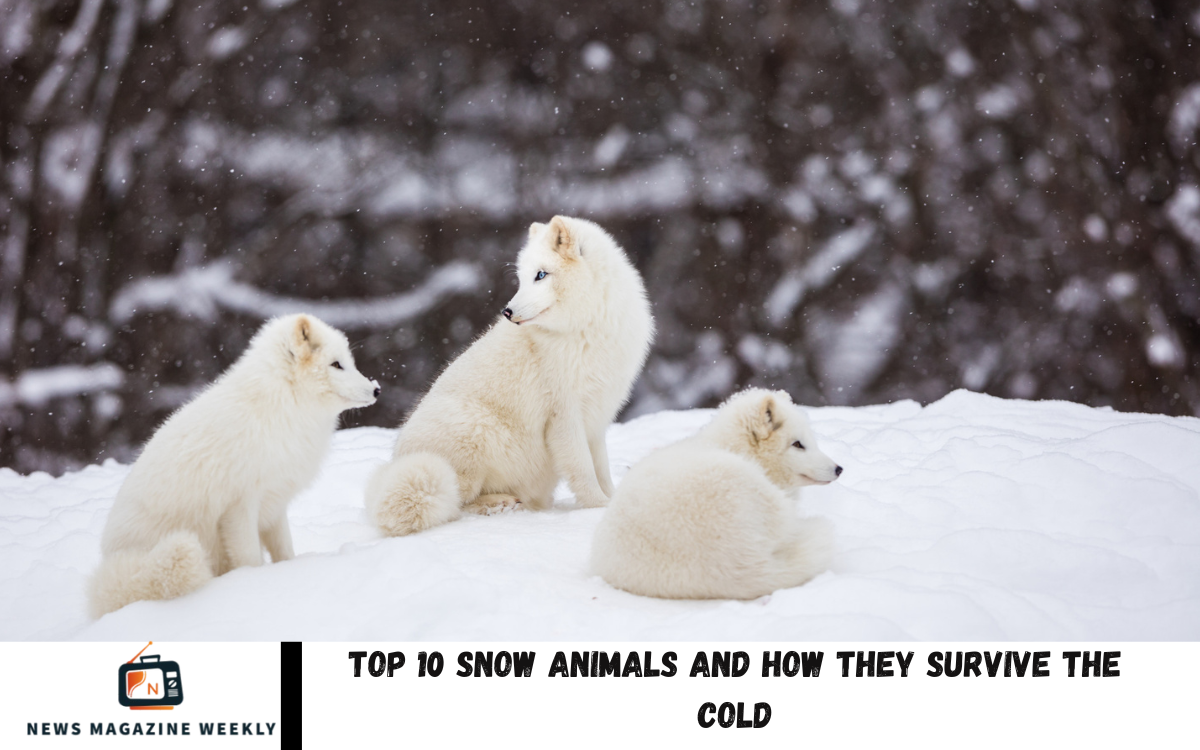Surviving in snowy, freezing environments is no easy task—but some animals are built for it. From thick fur to clever hunting habits, these snow-dwelling creatures have adapted in extraordinary ways to thrive in the harshest winter conditions. Whether it’s the Arctic fox blending into the snow or the emperor penguin huddling for warmth, each species has its survival secrets.
In this article, we’ll take a closer look at the top 10 snow animals that not only survive but thrive in icy habitats. These animals live in places where temperatures can drop far below freezing, yet they manage to find food, stay warm, and protect themselves from predators. Some grow extra layers of fat, others have unique body features, and a few even change color with the seasons!
Get ready to explore how nature’s most cold-hardy creatures—from wolves to snowy owls—battle the elements every day. Their fascinating adaptations will leave you amazed at just how powerful and resourceful wildlife can be when faced with extreme cold. Whether you’re a nature lover, student, or just curious about life in the snow, this list will open your eyes to the wonders of winter survival in the animal kingdom.
What Are Snow Animals?
Snow animals are wild creatures specially adapted to live in cold, snowy, and icy environments. They are found in places like the Arctic, Antarctic, high mountains, and tundras—regions where temperatures can drop far below freezing and snow covers the ground for most of the year.
Unlike other animals that hibernate or migrate to warmer areas, snow animals are built to handle extreme cold. They have unique features like thick fur, layers of fat, compact bodies, and even the ability to change color with the seasons (like the Arctic fox or snowshoe hare). These adaptations help them stay warm, find food, and hide from predators in snowy landscapes.
Snow animals include mammals like polar bears, Arctic wolves, and musk oxen, as well as birds like snowy owls and emperor penguins. Even some smaller animals, such as hares and rodents, have unique winter survival skills. These animals play an essential role in their ecosystems and show us just how amazing nature can be when it comes to adapting to harsh environments.
How Do Snow Animals Survive the Cold?
Snow animals have evolved incredible adaptations that help them not just survive but thrive in some of the harshest, coldest environments on Earth. From Arctic tundras to high mountain peaks, these creatures are perfectly equipped to handle freezing temperatures and icy conditions. Let’s take a look at some of the fantastic ways they manage to stay warm, find food, and avoid danger in the cold:
Thick Fur and Feathers
- Many snow animals, like polar bears and snowy owls, have dense fur or feathers that trap heat close to their bodies. The thick layers of fur help insulate them, keeping their body temperatures high even in sub-zero weather. Some animals, like the Arctic fox, even change their fur color with the seasons, providing both warmth and camouflage against the snow.
Fat Layers for Insulation
- This fat acts as insulation, keeping their bodies warm by preventing heat from escaping. The fat also serves as an energy reserve during the winter months when food is scarce.
Smaller, Compact Bodies
- Many cold-weather creatures, such as Arctic hares and snow leopards, have compact, stocky bodies that reduce the amount of heat lost through their surface area. Their short, thick limbs and rounded bodies help conserve warmth by limiting exposure to the cold air.
Huddling and Social Behavior
- Animals like emperor penguins and musk oxen rely on social behavior to stay warm. In the extreme cold, these animals huddle together in large groups to conserve body heat. The close contact helps them stay warm in otherwise freezing conditions, and some species even take turns being on the outer edges of the group, protecting the more vulnerable members.
Behavioral Adaptations
- Snow animals also exhibit certain behaviors to help them survive the cold. For example, some animals, like the caribou, migrate to areas with less snow or more food during the winter months. Others, like the snowshoe hare, burrow into the snow to create a warm shelter beneath the surface.
Through a combination of physical adaptations, social strategies, and clever hunting techniques, snow animals have found remarkable ways to survive and thrive in some of the coldest environments on Earth. Their resilience and resourcefulness in the face of extreme conditions are truly awe-inspiring!
Read Also: Meet 10 of the World’s Most Adorable Frogs
Top 10 Snow Animals You Should Know
Snow animals are fascinating creatures that have evolved incredible survival strategies to live in freezing, snow-covered environments. Here are 10 of the most fantastic snow in some of the harshest climates on Earth:
1. Arctic Fox
Camouflage and survival in the cold. Its thick white fur helps it blend into the snow, while its compact body and bushy tail keep it warm. It hunts small mammals and scavenges for food, using its keen sense of smell to detect prey buried under the snow.
2. Snow Leopard
This elusive big cat roams the rugged mountain ranges of Central Asia. Its thick fur and long tail help it stay warm in cold climates, and its powerful limbs make it an excellent climber. Snow leopards are also known for their stealth, using their spotted coat to blend into the snowy landscape while hunting.
3. Emperor Penguin
The largest of all penguin species, the emperor penguin is a true Antarctic survivor. These penguins huddle together in massive colonies to stay warm during the freezing winter months. Their thick layers of blubber and feathers protect them from the cold as they brave the harsh winds and icy waters to find food.
4. Polar Bear
The iconic polar bear is perfectly designed for life in the Arctic. It has a thick layer of fat, or blubber, beneath its skin, which helps it stay warm in freezing temperatures. Its white fur provides camouflage against the snow and ice, while its sharp claws and strong jaws allow it to hunt seals through the ice.
5. Caribou (Reindeer)
Caribou are known for their incredible migration journeys across the Arctic tundra. These animals have hooves that are specially adapted to help them dig through the snow to find food, like lichen. Their thick fur coats help keep them warm in extreme cold, and their hooves also act like snowshoes to prevent them from sinking into deep snow.
6. Snowy Owl
The snowy owl’s white feathers make it perfectly camouflaged against the snow. Its mighty wings allow it to silently swoop down and catch prey, such as lemmings, in the snowy terrain. Snowy owls are also known for their keen vision, which helps them spot prey from great distances.
7. Musk Ox
Musk oxen are large, powerful animals that live in the Arctic. Their thick coats of fur, combined with a layer of insulating fat, protect them from the cold. They are known for their strong social bonds and will form tight circles to shield themselves from the wind when temperatures plummet.
8. Arctic Hare
It has a white coat that provides both warmth and camouflage in the snowy tundra. Its strong hind legs allow it to move quickly, escaping predators like the Arctic fox. In winter, it also digs tunnels in the snow to create a cozy, warm home.
9. Wolverine
Despite its small size, the wolverine is one of the toughest animals in the snow. With powerful jaws and sharp claws, it can catch prey in the most frigid conditions. Its thick fur coat keeps it insulated, and it is capable of traveling great distances in search of food, even through deep snow.
10. Red Fox (Arctic Variant)
The Arctic red fox is a smaller, more compact version of its cousin found in other regions. It has thick, dense fur that helps it survive the extreme cold. During the winter months, its fur turns white to blend in with the snow, making it an expert predator in snowy environments.
These top 10 snow animals show us the incredible ways that nature helps creatures adapt to the most challenging environments. Each has its own unique set of survival strategies, from camouflage and body insulation to special hunting techniques, ensuring they thrive in the snow and ice!
Frequently Asked Questions
Do snow animals hibernate in the winter?
Most snow animals do not hibernate, but they may reduce their activity or enter a state of torpor during freezing periods. For example, some rodents and mammals may burrow in the snow or seek shelter to conserve energy, while others, like wolves and Arctic foxes, remain active year-round.
How do snow animals protect themselves from predators?
Snow animals often use camouflage, speed, and defensive behaviors to avoid predators. For example, snowy owls use their white feathers to blend into the snow, while Arctic hares use their strong legs to escape predators quickly. Musk oxen form tight circles to protect vulnerable members from predators.
Why are snow animals important to their ecosystems?
Snow animals play vital roles in maintaining the balance of their ecosystems. For instance, wolves and polar bears are apex predators that help control the population of other species. Herbivores like caribou also affect the vegetation in their habitats by grazing on mosses and lichen.
How do snow animals adapt to the dark winter months?
Some snow animals, like the Arctic fox and polar bear, have excellent senses of smell and hearing that help them hunt in dark or low-light conditions. Other animals, such as snowy owls, have exceptional vision that allows them to spot prey even in dim winter light.
Can snow animals survive if the climate warms up?
Serious threat to snow animals, as warming temperatures reduce the ice and snow they depend on. If temperatures continue to rise, these animals may struggle to find food and shelter.
Conclusion
Snow animals are nothing short of extraordinary, having the coldest and most challenging environments on Earth. From the thick fur and fat layers of the polar bear to the camouflage of the Arctic fox, each species has found unique ways to thrive in the icy tundras, snow-covered mountains, and frozen oceans of the world.

